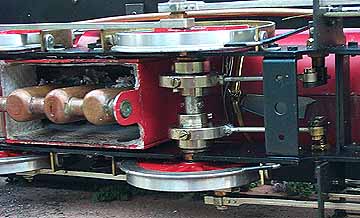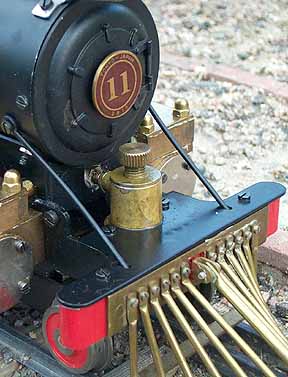
Back to Sidestreet Bannerworks
July 2003
Aster’s Reno
by Marc Horovitz

Named after the well-known city in Nevada, the Reno was built for the Virginia & Truckee Railroad by Baldwin in 1872. The V&T was a standard-gauge line in Nevada that primarily hauled gold and silver ore, which is what the Reno was put to work doing. After several decades of work, Reno started a career in pictures. Perhaps the most famous of these was Union Pacific in 1937.
The locomotive is a classic example of the American 4-4-0 and, along with the engines at Promontory Point, Utah, is among the most famous of its class. The engine exists today and was most recently featured in the film Wild, Wild West (1997). It was an ideal choice for Aster to model.
The model
Aster released the Reno in 1976. It was the company's third locomotive, after the Schools and the JNR Mogul, released the year before. In many ways, the Reno is like the Schools. They are both large-drivered 4-4-0s and both have Smithies boilers and slip-eccentric valve gear (actually, the Schools had slip return cranks, but the principle is the same).
The Reno is fitted with a water glass, while the Schools was not. The Reno might as well not have been fitted with one, as the glass can’t be trusted. The Aster catalog says that the engine also has a pressure gauge. Several of these locomotives have passed through my hands over the years and I've never seen one with a pressure gauge.
Another thing that the Reno has and the Schools does not is a hand pump in the tender. This, coupled with the chicken-feed alcohol system (also in the tender), allows the engine to be kept in steam indefinitely. Reno was built to the odd scale of 1:28, presumably to make it a little larger. Locomotives of its age were not very big.
The engine that I ran for this article is a recent acquisition. When I got it, it didn’t go. When tested on air, it was evident that none was getting to the cylinders. It was also evident that this was a kit-built locomotive, so I suspected that the builder had been over enthusiastic with the sealing compound around the cylinder covers and clogged up the passages. Upon removing one of the covers, it became immediately clear that I would have to look elsewhere. The compound had been expertly applied and all passages were unobstructed. I ultimately discovered that the problem lay in the throttle valve, which was blocked. I removed the needle valve and unscientifically poked a thin rod into the body of the valve, which cleared the blockage.
A test run on the bench revealed lumpy performance. Over the course of two or three more runs under steam, I adjusted the eccentrics and valves so that the engine would just tick over in either direction.
The run
After the usual oiling all around and the infusion of necessary fluids, I put the engine on the track and popped the fan into the stack. A Smithies-type boiler is internally fired, so requires the use of a suction fan to draw the fire until enough pressure has been raised to turn on the engine’s own blower. I opened the alcohol valve on the tender and, once the wicks were soaked, lit the fire. While steam was coming up, I gave the track a quick wipe down and pruned some infringing vegetation.
With pressure on the rise, I turned the blower on. Once that happens, the pressure comes up quickly. I closed the fuel valve, refilled the tank with alcohol, and reopened the valve. I pumped a little more water into the boiler, then opened the throttle. With a minimum of spitting and sputtering, the engine was off.
With its big drivers and not-very-sensitive throttle, this tends to be a very fast locomotive. However, with a light touch, you can just crack the throttle and get a good running speed out of it. Of course, adding a train helps to control the engine nicely.
When running light, a little blower must be left on, as the cylinders cannot generate enough exhaust pressure to keep the fire going. When pulling a couple of coaches, the blower can be closed entirely and the chuff of the engine becomes clearly audible.
We had a fine run this warm summer evening. Reno performed flawlessly, with a stop every few laps to add a little water to the boiler or fuel to the tank. This is a relatively simple, well designed locomotive that, once you learn its idiosyncrasies, is a pleasure to run. It’s a great thing to be able to just lean back in your lawn chair and watch the train go by, lap after lap.
.
|
|
|
| Builder | Aster Hobby Company, Inc. (Japan) |
| Date built | 1976 |
| Gauge | Nº 1 (45mm) |
| Scale | 1:28 |
| Boiler | Smithies with water tubes |
| Fittings | Throttle, blower, safety valve, water glass, check valve |
| Fuel | Alcohol, chicken-feed system |
| Blow-off pressure | 45 psi |
| Cylinders | Two, double-acting D-valve |
| Reversing gear | Slip eccentrics |
| Lubricator | Roscoe displacement |
| Dimensions | Length over all, 22-1/2"; width, 3-1/2"; height, 7" |
| Additional features | Hand pump in tender |






Right: A displacement lubricator sits proudly on the pilot deck. This is the dead-leg type. How it actually functions is one of life's great mysteries. Note the pilot, assembled from individual pieces.


.
Back to Sidestreet Bannerworks home page
This page and its contents
Copyright Sidestreet Bannerworks, 2003